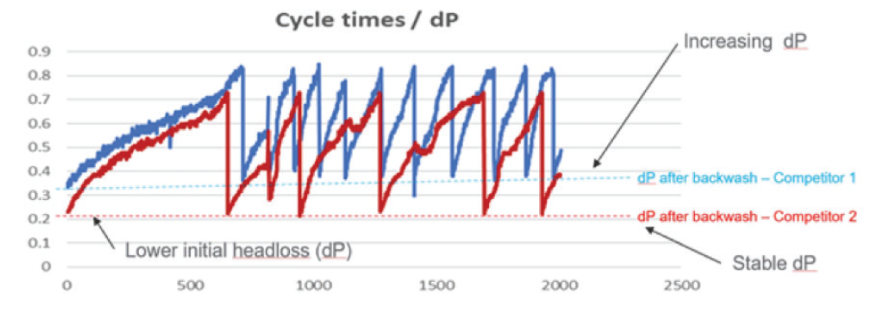The Dimensions of Filter Efficiency
When discussing filter efficiency, it is important to look at disc filtration as three dimensional. How do we measure a three-dimensional filtration element? The answer is dirt holding capacity (DHC). A filter’s DHC represents the number of particles (mg) retained on the filter medium during a single filtration cycle.
When discussing filter efficiency, the focus has always been on the size of the filtration area, or effective filtration area. This area is defined as the total area of the filter medium exposed to the water flow and which participates in the filtration process. To understand that filter efficiency is about much more than the size of the filtration area, let’s talk about how we define disc filter efficiency.
Conventionally, effective filtration area is discussed in a two-dimensional context. However, when it comes to disc filtration we should change to a three-dimensional way of thinking.
THE NEXT DIMENSION
Disc filtration, like media filtration, is multi-layered and offers depth filtration. This means there are second, third and successive chances to catch a particle in subsequent layers. Disc filters consist of a cylinder of compressed discs. Each disc has grooves that run in alternate directions that criss-cross when two discs are placed on top of each other, forming a series of meshes. These grooves form passages of varying dimensions through which the water passes from the outside to the inside of the discs. Water is filtered as it enters the cylinder of compressed discs from the outside to the inside.
The number of layers depends on the selected micron rating of the discs. In the case of Netafim disc filters’ unique disc design, there can be between 18 (for 400 micron discs) and 32 (for 20 micron discs) layers or stopping points in each track, resulting in unique depth filtration.
DIRT HOLDING CAPACITY
Considering this technical explanation of how a disc filter functions, it is clear why we could look at disc filtration as three dimensional. However, how do we measure a three-dimensional filtration element? The answer is dirt holding capacity (DHC). A filter’s DHC represents the number of particles (mg) retained on the filter medium during a single filtration cycle.
This concept can be expressed as the following mathematical equation:
Backwash total suspended solids (mg/l) x backwash volume (L) = DHC (mg).
The DHC of a filter will vary based on the filtration technology type used (surface or depth), water source quality (type of particles), working conditions (filtration velocity – Q/A, dP) and the filter element structure (porosity, depth, surface properties, construction material).
The DHC will determine a filter’s backwash frequency, which determines filtration efficiency. A higher DHC means fewer backwash cycles as the filter can hold more suspended solids. In addition, fewer backflush cycles save water and energy. If a filter’s backflushing cycle is inefficient, it will not only require more frequent backflushes; dirt will also accumulate on the filter over time.
This will eventually limit the filter’s ability to function, require manual cleaning and interrupt irrigation. If the filter does not revert to the initial head loss after a cleaning cycle, it means the filter’s backflush efficiency is low. This, of course, will reduce the DHC and increase the backflush frequency. If this inefficient backflush cycle continues, you will have to manually clean the discs more often.
The graph below describes the importance of low, stable head loss. The filter shown by the blue line has a lower DHC compared to the filter shown by the red line. The backflush action is also less efficient as indicated by the increased initial differential pressure. This means that the filter needs to backflush more frequently and causes lower filter efficiency in general.

It is clear, that a filter should not be judged by its effective filtration area alone. In the field, the filters compared above are both disc filters with similar filtration areas. However, there is a significant difference in how they respond in terms of backflush frequency and head loss maintenance.
MAINTENANCE IS KEY
Whether you define filter efficiency through DHC or not, efficiency cannot be maintained without proper and regular maintenance of the filter. Without it you will most likely encounter problems, and the filter will fail to protect the irrigation system all year. Increased initial differential pressure in the filter, due to poor maintenance, may also lead to decreased pressure in irrigation blocks.
Click here to read more about filter maintenance.


Share your thoughts
Comments
We'd love to hear your thoughts! To enter a comment, type your name and email address.